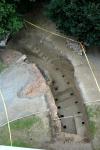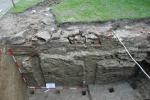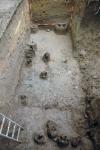Summary (English)
In the Virovitica City Park, at the site of the former medieval lowland fort of the 15th and 16th centuries, research was continued on the exploration of the remains of the fort. Two archaeological excavations were conducted: the continuation of the excavation of the foundations of the round tower in the NW part of the plateau, and the continuation of excavations in front of the entrance into the fortifications. Archaeological excavation of the tower in the previous year affected its southern and western parts, approaching the northeastern corner of the Pejačević castle. That part was particularly interesting because of the conservation study on the castle, which was led by Urbos (a studio for architecture, design and construction) from Osijek, and which was needed by the City Museum, which has been located in the inadequate premises of the castle since 1953, expanding spontaneously after the relocation of numerous tenants. Apart from small fragments of pottery from the 15th/16th century, animal bones, a small clay ball and many shells of marsh snails and shells were found at a depth of 1.20 m and further. Some pottery finds date the site to the 16th century, the time of the arrival of the Turks, the occupation of the fortress and its strengthening since it is now the westernmost border of the Turkish Empire. Parallel with the rescue excavation of the tower, another archaeological excavation was carried out in the City Park. Namely, in 1998 and 1999, the buried entrance to the medieval fort from the 15th century was unearthed on the western slope of the park, which was built by Count Pejačević and in the first half of the 19th century, a life-size stone herald and the family coat of arms were placed in front of the entrance. During 1998 and 1999, with the funds of the Ministry of Culture, the buried entrance to the fortress and the remains of the ramparts were excavated, where heralds and Pejačević‘s coat of arms were found. Only after their temporary relocation to the castle lobby and restoration, the archaeological excavation could be completed. Thus, trench S-1, size 5 × 3 m, was placed next to the promenade, 10 m away from the now-buried entrance, because it is awaiting restoration together with the remains of the brick wall. So far, in a relatively small area, along with an abundance of pottery fragments from the late Middle Ages and animal bones, around 10 vessels have been excavated that will be reconstructed. Rarely found fragments of glass, as well as decorative objects made of processed bone, speak of a richer layer of nobility in the fortress at that time, which was spared of the Turkish devastation. Archaeological artefacts date the site to the 15th century, at the same time as the entrance to the fortress (Silvija Salajić, Hrvatski arheološki godišnjak 2/2005, 91–93).
Director
- Silvija Salajić
Team
- Ana Bobovec
- Ana Kunac - Gradski muzej Makarska
Research Body
Funding Body
- Grad Virovitica
- Ministarstvo kulture Republike Hrvatske
- Virovitičko-podravska županija






![Download [PDF]](/excavation/skins/fasti/images/results/download_sml.png)

